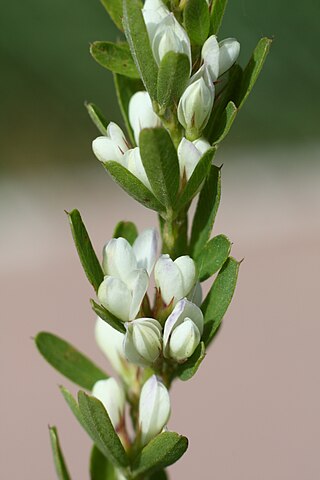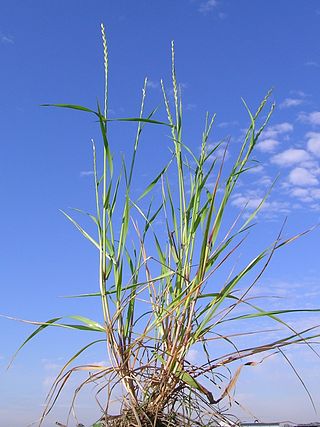
Forage is a plant material eaten by grazing livestock. Historically, the term forage has meant only plants eaten by the animals directly as pasture, crop residue, or immature cereal crops, but it is also used more loosely to include similar plants cut for fodder and carried to the animals, especially as hay or silage.

Spartium junceum, known as Spanish broom, rush broom, or weaver's broom, it is a species of flowering plant in the family Fabaceae and the sole species in the genus Spartium. It is closely related to the other brooms.

Trifolium subterraneum, the subterranean clover, subterranean trefoil, is a species of clover native to Europe, Southwest Asia, Northwest Africa and Macaronesia. The plant's name comes from its underground seed development (geocarpy), a characteristic not possessed by other clovers.

Ulex europaeus, the gorse, common gorse, furze or whin, is a species of flowering plant in the family Fabaceae, native to the British Isles and Western Europe.

Melilotus officinalis, known as sweet yellow clover, yellow melilot, ribbed melilot and common melilot, is a species of legume native to Eurasia and introduced in North America, Africa, and Australia.

Melilotus albus, known as honey clover, white melilot (UK), Bokhara clover (Australia), white sweetclover (US), and sweet clover, is a nitrogen-fixing legume in the family Fabaceae. Melilotus albus is considered a valuable honey plant and source of nectar and is often grown for forage. Its characteristic sweet odor, intensified by drying, is derived from coumarin.

Acaciella angustissima is most recognized for its drought tolerance and its ability to be used as a green manure and ground covering. It is a perennial, deciduous, and belongs to the family Fabaceae (beans/legumes) and as it grows it starts as a shrub but eventually matures to a small tree. The tree has a high density of leaves along with small clumps of white flowers and creates 4–7 cm long seed pods. Acaciella angustissima is found in tropical areas around the equator since, its water needs can vary from 750 to 2,500 mm a year. It has an advantage it can withstand a moderate drought, since its leaves are retained even in long dry periods. Aside from being drought tolerant, Acaciella angustissima also has the benefit of being a green manure, since it has such a high leaf density, but also loses the majority of its leaves each season. So the leaves can be used in composting or can be saved and used as livestock feed. It should only be used as an additive to the feed and not the main source, since it also toxic in high doses.

Medicago polymorpha is a plant species of the genus Medicago. It is native to the Mediterranean basin but is found throughout the world. It forms a symbiotic relationship with the bacterium Sinorhizobium medicae, which is capable of nitrogen fixation. Common names include California burclover, toothed bur clover, toothed medick and burr medic.

Ageratina adenophora, commonly known as Crofton weed, is a species of flowering plant in the family Asteraceae native to Mexico and Central America. Originally grown as an ornamental plant, it has become invasive into farmland and bushland worldwide. It is toxic to horses, which develop a respiratory disease known as Numinbah horse sickness after eating it.

Kummerowia is a genus of flowering plants in the legume family, Fabaceae. It includes two species native to eastern Asia, ranging from the Russian Far East through China and Japan to Vietnam and Laos. The genus belongs to the subfamily Faboideae. These plants were formerly in genus Lespedeza.

Trifolium hirtum, commonly known as rose clover, is a species of flowering plant in the legume family Fabaceae. It is indigenous to a range of regions spanning Europe, Western Asia, and North Africa, and has been introduced to other parts of the world where it is cultivated for various purposes.

Kummerowia striata is a species of flowering plant in the legume family known by the common names Japanese clover and common lespedeza. It is native to much of Asia and it is present in the eastern United States as an introduced species.

Lespedeza cuneata is a species of flowering plant in the legume family known by the common names Chinese bushclover and sericea lespedeza, or just sericea. It is native to Asia and eastern Australia and it is present elsewhere as an introduced species and sometimes an invasive plant.

Elymus lanceolatus is a species of grass known by the common names thickspike wheatgrass and streamside wheatgrass. It is native to North America, where it is widespread and abundant in much of Canada and the western and central United States. There are two subspecies, subsp. lanceolatus occurring throughout the species' range and subsp. psammophilus occurring in the Great Lakes region.

Elaeagnus pungens is a species of flowering plant in the family Elaeagnaceae, known by the common names thorny olive, spiny oleaster and silverthorn; also by the family name "oleaster". It is native to Asia, including China and Japan. It is present in the southeastern United States as an introduced species, a common landscaping and ornamental plant, and sometimes an invasive species.

Aeschynomene americana is a species of flowering plant in the family Fabaceae (legume) known by many common names, including shyleaf, forage aeschynomene, American joint vetch, thornless mimosa, bastard sensitive plant (Jamaica), pega pega, pega ropa, antejuela, ronte, cujicillo, and dormilonga. It is native to Central America, parts of South America, the West Indies, and Florida. It is now found in the US, in Australia and in South-East Asia.
Astragalus anisus is a species of flowering plant in the legume family known by the common name Gunnison milkvetch. It is endemic to Colorado in the United States, where it is limited to the Gunnison Basin of Gunnison and Saguache Counties.

Alysicarpus vaginalis is a species of flowering plant in the legume family, Fabaceae. It is native to parts of Africa and Asia, and it has been introduced to other continents, such as Australia and the Americas. It is cultivated as a fodder for livestock, for erosion control, and as a green manure. Common names include alyce clover, buffalo clover, buffalo-bur, one-leaf clover, and white moneywort.

Lolium rigidum is a species of annual grass. Common names by which it is known include annual ryegrass, a name also given to Italian ryegrass, rigid ryegrass, stiff darnel, Swiss ryegrass and Wimmera ryegrass. It is a native of southern Europe, northern Africa, the Middle East and the Indian subcontinent and is grown as a forage crop, particularly in Australia, where it is also a serious and economically damaging crop weed.

Crotalaria retusa is a species of flowering plant in the legume family known by various common names including devil-bean, rattleweed, shack shack, and wedge-leaf rattlepod. It is poisonous to livestock, and contaminates human food. Its original native range is unclear, probably including tropical Asia, Africa and Australia. It has been introduced as a crop plant in many tropical areas and has escaped from cultivation to become a troublesome weed; it is listed as a noxious weed in several US states, Puerto Rico, the Virgin Islands, and is listed as an invasive weed in India, Cuba, and Cocos Island. Unlike some other species of Crotalaria, it is an annual plant.



















